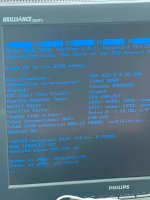thisisamigaspeaking
Experienced Member
- Joined
- Feb 13, 2024
- Messages
- 78
Wanted to get some feedback here before I go any further. My PGC powers and the CGA emulation does work, but it displays only blue. At first it was very dim, and I think it actually displayed only green (or maybe it was just very hard to see). It only works on one of my two LCDs that are appropriate for this. The cable's continuity checks out. The cable has the PGC's pin 5 (resolution select) connected to pin 14 of the VGA (V sync), and also has a connection from pin 4 (composite sync) on VGA's pin 13 (H or composite sync) of course, but removing that connection to 14 doesn't change anything.

I'm able to fix the sync/size/location issues with the monitor's settings so that's not a concern.
I am wondering if this is likely to be a DAC issue? Would it be reasonable to just go ahead and replace the DAC? I'm not sure if this is a failure mode of a video DAC or if it is more likely to mean the driver chips/circuits for red and green are not working. It's just a combined 4-4-4 bit DAC, not a RAMDAC afaik.
I think the PGC's CPU (or at least the CPU's general part of the boards) has to initialize for the CGA emulator to come on at all.
I have some limited electronics experience from may years ago, and know how to use the basic tools (solder, desolder, oscilloscope, etc.) but maybe I should leave this to someone with more experience? I would need to buy a scope but I have been thinking about getting a 200 MHz digital scope for a while.
I do have a logic diagram for the board.
Another thing is that DOS gives some kind of error beep when it loads and the video cuts out. I could try disabling the PGC's CGA emulation and putting another video card in it so I can run the PGC diagnostics, but the problem with VGA in general is that the usual BIOS area at C0000h (other than IBM VGA) overlaps with with the PGC's interface at C6000h.
Ideas?

I'm able to fix the sync/size/location issues with the monitor's settings so that's not a concern.
I am wondering if this is likely to be a DAC issue? Would it be reasonable to just go ahead and replace the DAC? I'm not sure if this is a failure mode of a video DAC or if it is more likely to mean the driver chips/circuits for red and green are not working. It's just a combined 4-4-4 bit DAC, not a RAMDAC afaik.
I think the PGC's CPU (or at least the CPU's general part of the boards) has to initialize for the CGA emulator to come on at all.
I have some limited electronics experience from may years ago, and know how to use the basic tools (solder, desolder, oscilloscope, etc.) but maybe I should leave this to someone with more experience? I would need to buy a scope but I have been thinking about getting a 200 MHz digital scope for a while.
I do have a logic diagram for the board.
Another thing is that DOS gives some kind of error beep when it loads and the video cuts out. I could try disabling the PGC's CGA emulation and putting another video card in it so I can run the PGC diagnostics, but the problem with VGA in general is that the usual BIOS area at C0000h (other than IBM VGA) overlaps with with the PGC's interface at C6000h.
Ideas?
Last edited:

